Puntigrus anchisporus
SynonymsTop ↑
Barbus anchisporus Vaillant 1902; Systomus anchisporus (Vaillant 1902); Puntius anchisporus (Vaillant 1902)
Etymology
Puntigrus: formed from part of the generic name Puntius and tigrus, a word created to sound like the Latin word tigris, meaning ‘tiger’, in allusion to the barred colour pattern and the common name ‘tiger barb’ used for some members.
anchisporus: Vaillant did not specify the precise derivation, but probably from the Ancient Greek ἄγχῐ (akchi), meaning ‘near’, and σπόρος (spóros), meaning ‘offspring’, in reference to this species’ resemblance to certain other small cyprinids.
Classification
Order: Cypriniformes Family: Cyprinidae
Distribution
Endemic to Borneo, with Indonesian records from the Kapuas and Mempawah rivers in Kalimantan Barat (West Kalimantan) province, Maruwei, Pembuang, Teweh, and Kahayan watersheds in Kalimantan Tengah (Central Kalimantan), plus the Negara and Jorong drainages in Kalimantan Selatan (South Kalimantan).
It also occurs throughout much of Sarawak state in the Malaysian part of the island, although official records are lacking (M. Lo, pers. comm.; pers. obv.).
Type locality is ‘Kapuas River, Borneo, Indonesia’.
Habitat
Occurs in forest streams and tributaries containing relatively clear water and sandy to rocky substrates. Marginal vegetation tends to grow thickly and the water may be stained yellowish with tannins and other organic substances.
Beds of aquatic plants from genera such as Cryptocoryne or Barcalaya and patches of submerged leaf litter can be found in some habitats.
Sympatric species include members of Desmopuntius, Eirmotus, Rasbora, Gastromyzon, Nemacheilus, Pangio, and Paracrossocheilus.
Maximum Standard Length
50 – 60 mm.
Aquarium SizeTop ↑
An aquarium measuring at least 80 ∗ 30 ∗ 30 cm is required.
Maintenance
Choice of décor is not especially critical though it should display better colouration in a well-decorated set-up. The addition of floating or overhanging vegetation and driftwood roots or branches also seems to be appreciated by members of this genus.
Water Conditions
Temperature: 20 – 26 °C
pH: 5.5 – 7.0
Hardness: 18 – 179 ppm
Diet
Probably an omnivore feeding primarily on insect larvae and zooplankton, but also known to browse plant material and organic detritus (pers. obv.).
In the aquarium offer regular meals of small live and frozen foods such as chironomid larvae (bloodworm), Daphnia, and Artemia alongside good quality dried products.
Behaviour and CompatibilityTop ↑
Limited aquarium observations suggest this species to be peaceful when provided with a sufficiently large aquarium and well-chosen tankmates.
It is a gregarious species forming loose hierarchies, with rival males continually battling with each other for female attention and hierarchical position within the group. A group of at least 8-10 specimens should therefore be considered the minimum purchase.
Sexual Dimorphism
Adult males tend to be slightly smaller, slimmer, and possess a more intense colour pattern than females.
Reproduction
Unrecorded.
NotesTop ↑
This species occasionally appears in the aquarium hobby, but the trade is largely reliant on commercially-produced ‘tiger barbs’ of questionable origin.
It is distinguished from congeners by the following combination of characters: lateral line complete; 14 circumpeduncular scales; 21-23+2 scales in the lateral row; dorsal-fin black with red outer band; pelvic fins red.
The genus Puntigrus was raised by Kottelat (2013) in order to accommodate a group of species formerly referred to as the ‘Puntius tetrazona group’. Other members are P. tetrazona, P. navjotsodhii, P. pulcher, and P. partipentazona, of which the first three are native to western, central, and eastern Borneo, respectively, and the latter to Indochina.
This assemblage is diagnosed by possession of a unique colour pattern comprising 4 black bars on a pale body, and black pigmentation on at least the basal half of the dorsal-fin. The anteriormost body bar passes through the eye, the second is anterior to the pelvic-fin base, the third is above the anal-fin and continues onto it, and the posteriormost is at the caudal-fin base.
The following combination of characters also aid in identification, although individually they are not unique to the genus: body rhomboid, deep; last simple dorsal-fin ray serrated posteriorly; rostral barbels absent; maxillary barbels present; lips smooth and thin, postlabial groove interrupted medially; lateral line complete or incomplete; 18–23 lateral line scales; 9½–10½ [5½/1/3–4½] scale rows between dorsal-fin origin and ventral midline anterior to pelvic-fin base; 12–14 circumpeduncular scale rows; 8–9 rakers on first gill arch.
The genus Puntius was previously viewed as a polyphyletic catch-all containing over 100 species, but this situation has been largely resolved since the turn of the century.
References
- Vaillant, L. L., 1902 - Notes from the Leyden Museum 24 (note 1): 1-166, Pls. 1-2
Résultats zoologiques de l'expédition scientifique Néerlandaise au Bornéo central. - Alfred, E. R., 1963 - Bulletin of the National Museum of Singapore 32: 135-142
Some Colourful Fishes of the Genus Puntius Hamilton. - Collins, R., K. F. Armstrong, R. Meier, Y. Yi, S. D. J. Brown, R. H. Cruickshank, S, Keeling, C. Johnston, 2012 - PLoS ONE 7(1): e28381
Barcoding and Border Biosecurity: Identifying Cyprinid Fishes in the Aquarium Trade - Kottelat, M., 1992 - Raffles Bulletin of Zoology 40(2): 187-192
The identity of Barbus johorensis Duncker, 1904 (Teleostei: Cyprinidae). - Kottelat, M., 2013 - Raffles Bulletin of Zoology Supplement 27: 1-663
The fishes of the inland waters of southeast Asia: a catalogue and core bibiography of the fishes known to occur in freshwaters, mangroves and estuaries. - Kottelat, M. and E. Widjanarti, 2005 - Raffles Bulletin of Zoology Supplement 13: 139-173
The fishes of Danau Sentarum National Park and the Kapuas Lakes area, Kalimantan Barat, Indonesia. - Kottelat, M. and H. H. Tan, 2011 - Ichthyological Exploration of Freshwaters 22(3): 209-214
Systomus xouthos, a new cyprinid fish from Borneo, and revalidation of Puntius pulcher (Teleostei: Cyprinidae). - Pethiyagoda, R., 2013 - Zootaxa 3646(2): 199
Haludaria, a replacement generic name for Dravidia (Teleostei: Cyprinidae). - Pethiyagoda, R., M. Meegaskumbura, and K. Maduwage, 2012 - Ichthyological Exploration of Freshwaters 23(1): 69-95
A synopsis of the South Asian fishes referred to Puntius (Pisces: Cyprinidae). - Roberts, T. R., 1989 - Memoirs of the California Academy of Sciences 14: i-xii + 1-210
The freshwater fishes of western Borneo (Kalimantan Barat, Indonesia). - Tan, H-H., 2012 - Raffles Bulletin of Zoology Supplement 25: 285-289
Systomus navjotsodhii, a New Cyprinid Fish from Central Kalimantan, Borneo.
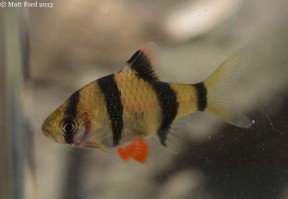

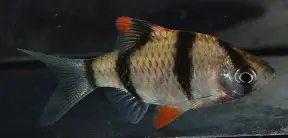


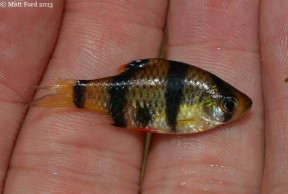
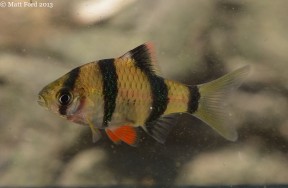

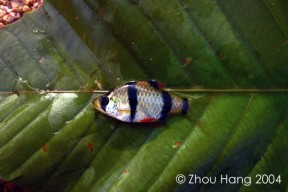
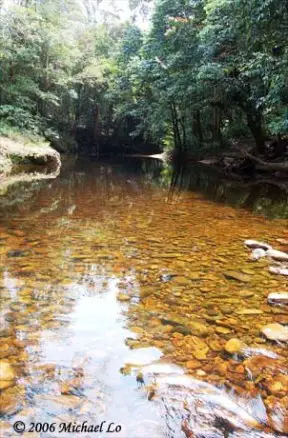


January 11th, 2014 at 10:33 pm
I was lucky enough to get a group of 20 wild Anchisporus and as yet haven’t noticed any aggressive behaviour either towards each other or indeed other fishes ,although I must say I do keep them with other species of Barbs so I guess they may not be able to really stamp their authority as they indeed might with slower moving fishes ?
Also when I first bought them they were quite small and really very shy even though kept as a fair sized group , I have now moved them into larger quarters and they have really blossomed into Beautiful fish ,somtimes shoaling other times forming loose little groups !